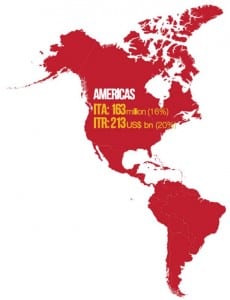NORTH AMERICA
Inbound tourism:
Most tourism within North America is domestic. The majority of visitors to the USA come from neighboring countries such as Mexico and Canada (Burton, 1995). In 2010, there were 60 million international arrivals, of which one third were Canadian (Boniface & Cooper, 2012). A similar pattern can be seen in Canada with most foreign tourists coming from the USA; less than 10% of its 16 million international arrivals come from European countries.
Outbound tourism:
Outbound tourism is similar to the pattern of inbound tourism. The majority of people tend to holiday within the region with most Americans holidaying in Canada or Mexico (Burton, 1995) and most Canadians travelling to America to states such as New York, Vermont and Washington (Boniface & Cooper, 2012).
SOUTH AMERICA & THE CARIBBEAN
Tourism in South America and the Caribbean is still on a relatively small scale (Burton, 1995) when compared to that of North America. However, the two regions also rely heavily on intraregional travel with most of its tourists being from the North American market. Although this can be thought of as a positive, the two regions’ tourism sectors could suffer if there were ever a recession in the north of America. The destinations also have strong links with France and the Netherlands (Boniface & Cooper, 2012). Outbound tourism in these regions is also relatively low due to a relatively poorer source of income.
The following image highlights the total international tourist arrivals and international tourism receipts for the Americas in 2012:
(UNWTO, 2013)
